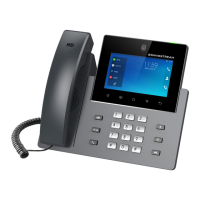SIP URI
Scheme
When Using
TLS
Defines which SIP header, “sip” or “sips”, will be used if TLS is selected for SIP Transport.
The default setting is “sip”.
Ephemeral
Port in
Contact
with
TCP/TLS
Determines the port information in the Via header and Contact header of SIP message when the phone
system use TCP or TLS. If set to No, these port numbers will use the permanent listening port on the phone.
Otherwise, they will use the ephemeral port for the particular connection.
The default setting is “No”.
Support SIP
Instance ID
Determines if the phone system will send SIP Instance ID. The SIP instance ID is used to uniquely identify the
device. If set to “Yes”, the SIP Register message Contact header will include +sip.instance tag.
The default setting is “Yes”.
SIP T1
Timeout
Defines an estimate of the round-trip time of transactions between a client and server. If no response is
received in T1, the figure will increase to 2*T1 and then 4*T1. The request re-transmit retries would continue
until a maximum amount of time define by T2.
The default setting is 0.5 sec.
SIP T2
Interval
Specifies the maximum retransmit time of any SIP request messages (excluding the SIP INVITE message).
The re-transmitting and doubling of T1 continues until it reaches the T2 value.
The default setting is 4 sec.
SIP Timer D
Interval
Defines the amount of time that the server transaction can remain when unreliable response (3xx-6xx)
received. The valid value is 0-64 seconds.
The default value is 0.
Remove
OBP from
Route
Configures the phone system to remove the outbound proxy URI from the Route header. This is used for the
SIP Extension to notify the SIP server that the device is behind a NAT/Firewall. If it is set to “Yes”, it will
remove the Route header from SIP requests.
The default setting is “No”.
Enable
100rel
Use route
set in
NOTIFY
(Follow RFC
6665)
Actives PRACK (Provisional Acknowledgment) method. PRACK improves the network reliability by adding an
acknowledgement system to the provisional Responses (1xx). It is set to “Yes”, the phone system will
response to the 1xx response from the remote party.
Default is “No”.
Configures whether to use route set in NOTIFY (follow RFC 6665). If enabled, the Request URI of the
refresh/cancel subscription will use the URI in the received NOTIFY Contact (RFC 6665); otherwise, the URI in
the previously subscribed 200 OK Contact will be used.
Timer
Session
Timer
Allows the phone system to use the session timer, when set to “Yes”, it will be added in the SIP INVITE
message to notify the server.
Session
Expiration
(s)
Configures the phone system’s SIP session timer. It enables SIP sessions to be periodically “refreshed” via a
SIP request (UPDATE, or re-INVITE). If there is no refresh via an UPDATE or re-INVITE message, the session
will be terminated once the session interval expires. Session Expiration is the time (in seconds) where the
session is considered timed out, provided no successful session refresh transaction occurs beforehand.
The default setting is 180. The valid range is from 90 to 64800.
Min-SE (s)
Determines the minimum session expiration timer (in seconds) if the phone act as a timer refresher.
The default setting is 90. The valid range is from 90 to 64800.

